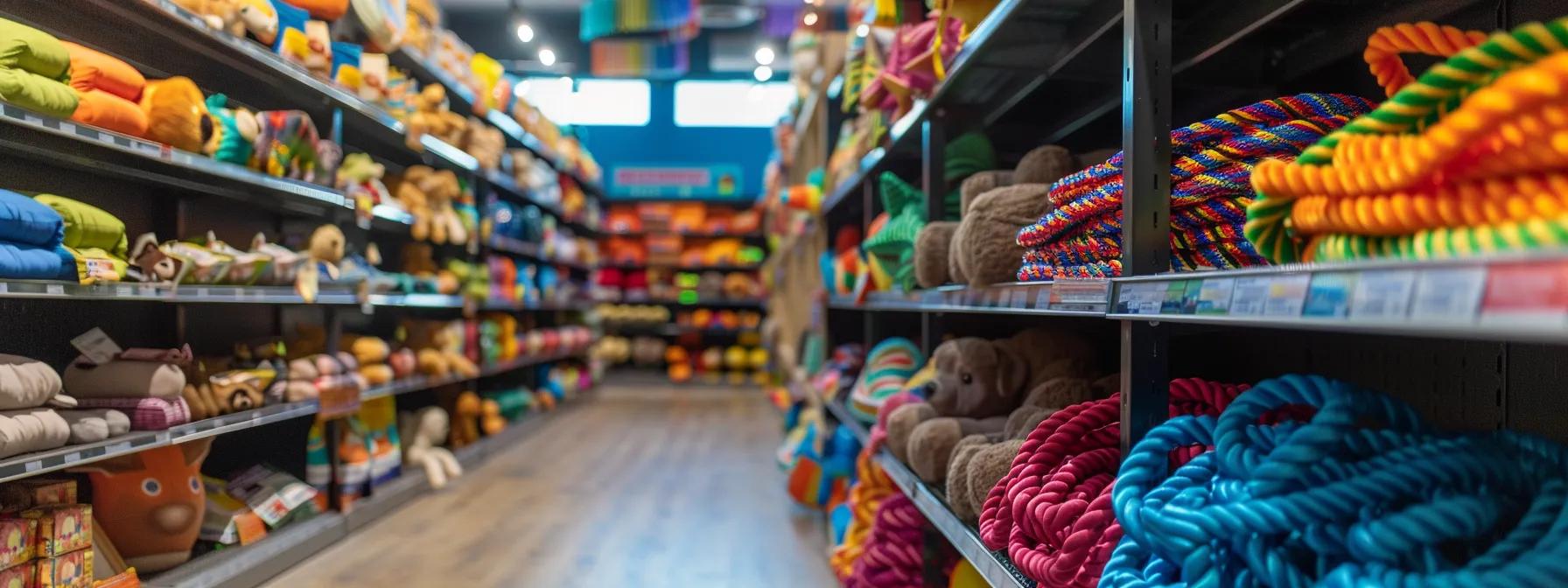
Safe Materials for Durable Rope Dog Toys
Using safe, non-toxic materials in dog toys is essential for protecting pets from harmful chemicals and reducing the risk of injury. Manufacturers and pet owners alike must consider the composition of dog toys—especially rope toys—to determine if they meet safety standards and can withstand rigorous chewing without releasing toxic substances. This article provides an in-depth exploration of the materials used in dog toys and ropes, outlines potential risks, and describes the best practices for selecting, maintaining, and inspecting toys to guarantee they remain safe throughout their lifecycle.
When dogs chew on toys, they may ingest small amounts of substances that could ultimately harm their gastrointestinal tract or teeth. Therefore, understanding what goes into these products is critical for both health and durability. The article reviews non-toxic components, examines how natural rubbers and food-grade materials can be beneficial, and details which plastics and synthetic fibers to avoid due to risky chemicals such as phthalates and bisphenol A. An informed approach to pet toy safety not only preserves a pet’s health but also extends the lifespan of the toy, reducing waste and costs in the long run.
Additionally, considerable attention is given to rope dog toys. Rope materials must be both durable and free of contaminants like heavy metals or toxic dyes. Pet owners can use this resource to verify that the toy construction is reliable and that any potential hazards—from choking hazards to internal blockages—are minimized. The article provides detailed guidance on inspecting toy construction and understanding labeling so that buyers can confidently choose high-quality, safe products for their canine companions.
Transitioning now to the detailed examination of materials and their properties, the following sections will cover each key area that impacts the overall safety and durability of dog toys and chews.
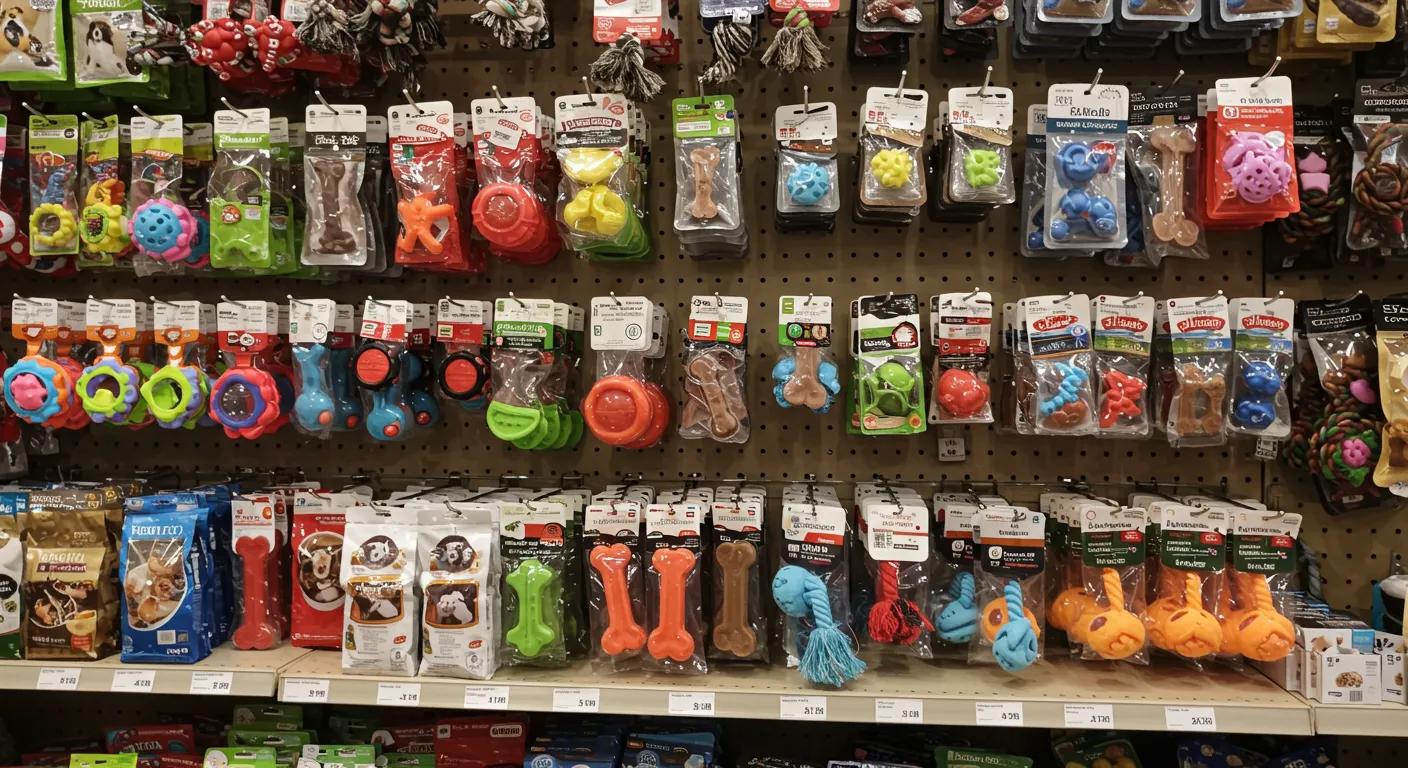
Understanding Safe Materials for Dog Toys and Chews
Identifying Non-Toxic Components in Pet Playthings
Non-toxic components are those materials that have been tested and confirmed without hazardous substances. Materials like natural rubber, food-grade silicone, and untreated cotton represent safe options. Pet toys relying on synthetic additives can sometimes contain hidden toxins, but using certified non-toxic compounds ensures products will not release harmful chemicals such as chromium or lead into the mouth. For instance, natural rubber extracted from Hevea brasiliensis, when processed adequately, is free from harmful additives and is highly resilient, providing a safe and durable chew option.
A growing body of research has shown that consumers are increasingly demanding products that do not contain traces of dangerous chemicals like phthalates or formaldehyde. Regulatory agencies in several countries now enforce strict compliance measures for pet products, making the identification of non-toxic components more critical. Manufacturers are encouraged to adopt clear labeling and certification practices, including the use of independent testing laboratories. This helps guarantee that components such as gums and coatings remain inert and do not degrade into substances that might irritate a dog’s gastrointestinal tract or cause allergic reactions.
Pet owners should look for products with certifications, including third-party testing labels that verify the absence of toxic additives. When selecting chewable items or stuffed toys, ensure that materials are either plant-based or derived from food-grade sources. These details not only secure a pet’s health but also instill consumer confidence in the manufacturing brand.
Recognizing Harmful Chemicals to Avoid in Dog Toys
Toxic chemicals in dog toys can include substances such as phthalates, bisphenol A (BPA), and heavy metals like lead and cadmium. Phthalates, often used as plasticizers, can leach into saliva and cause hormonal disruption when ingested over time. Similarly, BPA is known for its estrogen-mimicking effects and may be present in some plastics and resins. Additionally, dyes used in toy manufacturing can contain chemicals that may be carcinogenic or highly allergenic to sensitive dogs.
Studies have shown that even small amounts of these chemicals can accumulate in a pet’s system, potentially leading to long-term health issues. The risk is higher when toys are subjected to continuous wear and tear, which might cause them to break down and release particulate matter. Furthermore, manufacturing processes sometimes utilize solvents and other chemicals that could remain as residues in the final product.
For pet owners, it is critical to avoid toys that do not specify non-toxic claims or fail to provide certification of chemical safety. Always question ambiguous language on packaging; phrases like “made with natural colors” should prompt further research on the actual chemical composition. Research continues to show that the gastrointestinal tract is particularly vulnerable to ingesting micro-particles from degraded toy material. By eliminating exposure to these harmful chemicals, pet owners can reduce the risk of allergy, toxicity, or longer-term hormonal disruptions in their animals.
Benefits of Natural Rubber as a Safe Material for Dog Toys
Natural rubber stands out as one of the most durable and safe materials available for dog toys. Derived from natural sources such as rubber trees, this material is biodegradable and free from many synthetic additives that pose a risk to pets. When processed using food-grade methods, natural rubber does not include residual chemicals that can leach into a dog’s saliva. Its inherent elasticity and resilience make it ideal for chewers and vigorous play enthusiasts.
Scientific studies indicate that natural rubber can improve the longevity of a toy when compared to certain plastics, as it maintains its structural integrity under repetitive chewing. Unlike many synthetic alternatives, natural rubber is less likely to contain harmful substances like phthalates or bisphenol A. Furthermore, because it is sourced from renewable resources, it supports environmentally friendly practices in pet product manufacturing.
The tactile properties of natural rubber also contribute to dental health. As dogs chew rubber toys, the material’s texture can help remove plaque and provide a massaging effect on the gums. This dual benefit—encouraging play while supporting dental hygiene—ensures that a natural rubber toy is not only safe but also multifunctional. Pet owners are encouraged to verify that the rubber used in dog toys carries a food-grade certification to ensure that it meets the necessary safety standards.
Why Food-Grade Materials Benefit Your Canine Companion
Premium, food-grade materials offer several benefits for dog toys and chews. These materials are manufactured in environments that adhere to strict hygiene and safety standards, ensuring that no harmful chemical residues remain. Food-grade classifications require rigorous testing, which minimizes the risk of contamination from heavy metals, toxic dyes, or chemical additives. When a dog chews on a toy made from food-grade materials, the risk of ingesting unsafe particles is greatly reduced.
Pet owners and manufacturers alike appreciate food-grade materials for their consistency in quality. For example, food-grade silicone, widely used for squeaky toys or teething items, is heat resistant, durable, and completely inert. Such materials are less likely to break down into harmful fragments over time and provide a higher assurance of uniformity in performance. Additionally, many food-grade compounds are also designed to withstand high temperatures during sterilization, meaning these products are both safe and easy to clean without the loss of material integrity.
Using food-grade materials enhances the overall reliability of a toy in terms of safety, durability, and environmental impact. Manufacturers who adopt food-grade quality are more likely to earn trust and loyalty from pet owners, leading to better market performance and safer pet products. This benefit extends to reducing the financial liability of potential recalls or health hazards associated with toxic materials.
Selecting Safe Plastics for Dog Toy Manufacturing
While many dog toys are composed partly of plastic, not all plastics are created equal. Secure and safe plastics for dog toys must be carefully selected to meet rigorous safety standards regarding toxicity and durability. Pet-safe plastics often include high-density polyethylene (HDPE) and polypropylene, which do not contain harmful additives like phthalates or bisphenol A, ensuring that they are less likely to leach dangerous substances when chewed.
Safe plastics should undergo methods of stabilization to prevent degradation into microplastics under constant stress and exposure to UV light. Manufacturers that invest in durable plastic formulations can reduce risks such as internal blockages from swallowed toy fragments or accidental choking hazards. Additionally, products that include robust testing for heavy metal contaminants like lead and cadmium offer an extra layer of reassurance for pet owners.
For any toy labeled as “pet-safe” or “non-toxic,” it is advisable to verify the testing standards cited on the packaging. Consumer reports and third-party inspection labels can serve as a guide to confirm that the plastic materials have indeed passed stringent safety evaluations. Ultimately, the careful selection of safe plastics forms a cornerstone for building durable dog toys that protect your pet against both physical injury and chemical toxicity.
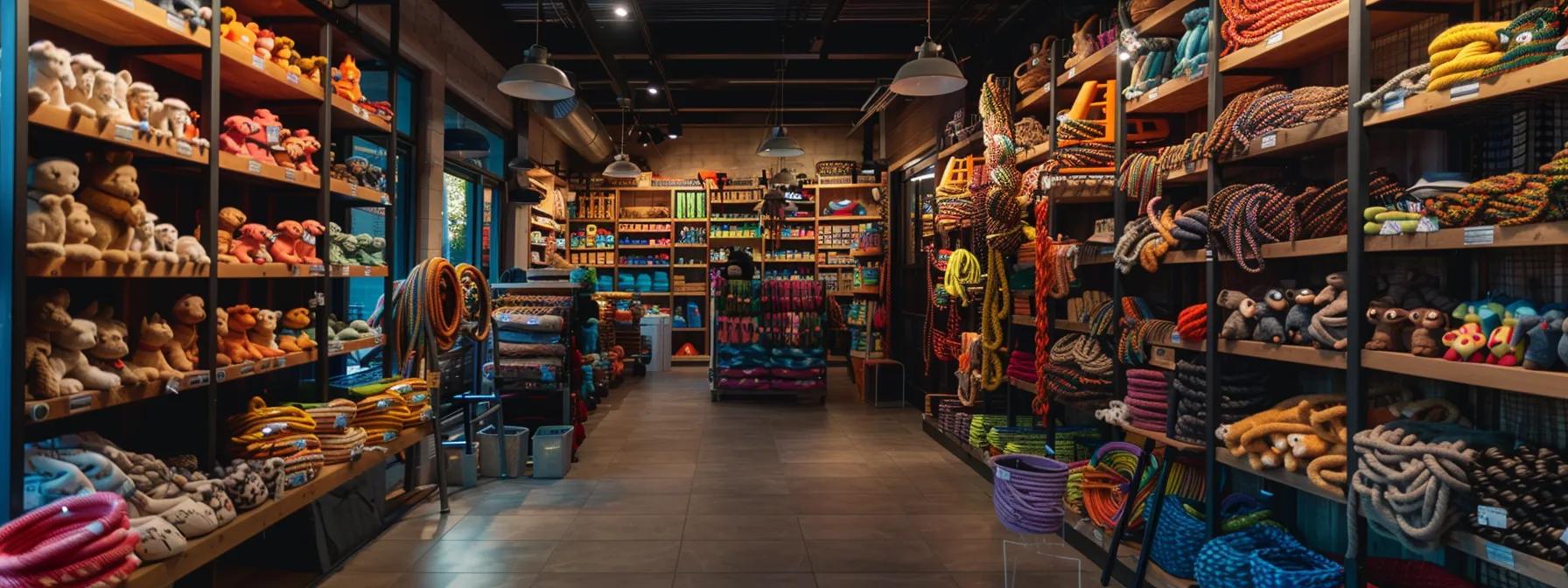
Selecting Safe Materials for Durable Rope Dog Toys
Properties of Pet-Safe Natural Fibers Ideal for Rope Toys
Natural fibers, such as cotton, jute, and sisal, offer exceptional safety profiles for rope dog toys. These fibers are derived from renewable plant sources and are inherently biodegradable. Cotton, in particular, is soft yet durable, which makes it an excellent choice for dogs that are aggressive chewers because it minimizes risk of dental damage or choking. Jute provides a rougher texture that can help improve gum health, while sisal, known for its strength, maintains integrity under substantial chewing forces.
The appeal of natural fibers lies in their low toxicity, minimal chemical processing, and high levels of breathability, allowing for safe wear during extended play sessions. Scientific analysis confirms that many natural fibers contain no harmful dyes, additives, or heavy metals. This is essential because, during the manufacturing process, fabrics might be treated with chemicals that could become hazardous. Manufacturers committed to using pet-safe natural fibers ensure that the material is either untreated or processed with non-toxic agents.
Furthermore, luxury brands often highlight the sustainable sourcing of these fibers. The sustainable harvesting of cotton or jute reduces environmental impact and demonstrates compliance with eco-friendly practices. The tactile feel of natural fibers enhances a pet’s play experience by providing a comforting texture that’s gentle on sensitive gums and teeth. By choosing high-quality, non-toxic natural fibers, consumers secure a rope toy that not only withstands intense chewing but also promotes safer play by limiting the release of microfibers that might be ingested.
Assessing the Durability and Safety of Cotton Rope Toys
Cotton rope toys are popular due to their softness and versatility. When evaluating their safety, both the quality of the cotton used and the manufacturing methods become critical. High-grade cotton with a tight weave reduces the risk of strands unraveling and forming small, dangerous pieces that could be swallowed. Durable cotton can handle repeated tugging and biting without fraying excessively, which ensures that the toy continues providing a safe chewing experience over extended periods.
Manufacturers often use specific weaving techniques to reinforce cotton rope structures, so it is important to check that the rope has been bound or braided in a way that minimizes wear and tear. Quality assurance assessments picture features such as double stitching or additional binding materials that help maintain the rope’s structural integrity. Field tests often demonstrate that cotton rope toys can withstand hundreds of hours of active use without significant degradation. This is crucial because even safe materials can turn hazardous if their physical structure deteriorates, potentially leading to choking hazards or stray fibers coming loose.
Furthermore, cotton is renowned for its hypoallergenic properties. For dogs with sensitive skin or pre-existing allergies, ensuring that cotton rope toys are free from chemical treatments is paramount. Certification from independent laboratories verifying the absence of harmful residues like formaldehyde or heavy metals can provide extra assurance. Pet supply brands that prioritize these testing standards help protect pets from developing allergic reactions or gastrointestinal distress due to ingestion of degraded cotton fibers. As such, both durability and safety criteria should be part of a thorough assessment when selecting cotton rope toys for energetic chewers.
Understanding Hemp as a Secure Rope Toy Material
Hemp is emerging as a highly secure material for durable rope dog toys due to its exceptional strength, resistance, and environmental benefits. Derived from the Cannabis sativa plant, hemp fibers are naturally robust and offer excellent tensile strength compared to other natural fibers. This durability means that hemp rope toys are less likely to break under intense chewing, reducing the occurrence of dangerous fragments or loose tassels that could pose choking hazards.
Hemp is also inherently resistant to mold and bacteria, an important trait given that dog toys are frequently exposed to moisture from saliva or outdoor conditions. Its natural composition requires minimal chemical processing, which minimizes the risk of residual toxins such as heavy metals or harmful dyes. Studies have indicated that hemp-based fibers maintain strength even after repeated washing, suggesting that rope toys made from hemp can be easily cleaned without compromising on product longevity or safety.
Additionally, hemp’s structure is well-regarded for its anti-microbial properties, reducing the potential for bacterial colonization that might lead to gastrointestinal disturbances or infections in dogs. The eco-friendly credentials of hemp cannot be overstated—it grows quickly without the need for harmful pesticides, making it a sustainable and safe alternative to synthetic materials. Pet owners who prioritize both animal health and environmental considerations are increasingly turning to hemp rope toys as an optimal choice for safe dog play.
Potential Hazards Associated With Synthetic Rope Materials
Synthetic ropes, such as those made from nylon or polyester, are commonly used due to their high tensile strength and versatility. However, they present certain hazards when used in dog toys. Over time, synthetic ropes may begin to fray, exposing small fibers that can be ingested, leading to potential internal blockages or choking hazards. The manufacturing process of these materials can also involve chemicals like dyes, flame retardants, or plasticizers—substances that might be not only hazardous if ingested, but also potentially detrimental to a dog’s oral health.
Moreover, the degradation of synthetic fibers can lead to the formation of microscopic particles. Many of these particles are virtually impossible for the body to eliminate, potentially accumulating in the gastrointestinal tract and causing digestive issues or chronic inflammation. Certain plastics are susceptible to releasing low levels of toxic substances over time, such as bisphenol A (BPA) or phthalates, which when chewed repeatedly may leach into a dog’s system.
Owners should also be aware that synthetic ropes do not biodegrade, posing environmental hazards and contributing to microplastic pollution if discarded improperly. Assessing a synthetic rope toy’s quality involves checking its manufacturing credentials, ensuring that it undergoes rigorous testing for hazardous chemical residues. Pet owners must also be vigilant in monitoring the wear and tear of synthetic rope toys to preemptively discard them before they become fragmented hazards. Overall, while synthetic materials can offer durability, the potential risks associated with chemical additives and fiber degradation necessitate careful evaluation.
Inspecting Rope Toy Construction for Overall Safety
The safety of a rope dog toy hinges not only on the material used but also on how it is constructed. Inspecting the construction involves a comprehensive review of the design, manufacturing techniques, and assembly quality. Key indicators of a well-constructed rope toy include tightly braided fibers, secure knots, and reinforced ends that prevent fraying. A rope toy with exposed loose fibers or poorly secured knots increases the risk of small pieces breaking off, which may be ingested and cause choking or gastrointestinal blockages.
Quality control measures during manufacturing should ensure that the rope is uniform in thickness and free from contaminants. Manufacturers that adhere to strict safety standards often publish quality assurance documentation and third-party certifications verifying that no harmful chemicals have been used. Additionally, robust rope toy construction should include internal bonding agents that are non-toxic and food-grade, further ensuring that, even if some degradation occurs, the integrity of the toy remains uncompromised.
For pet owners, routine visual inspections of rope toys are essential. Check for signs of wear such as fraying or discoloration, and feel the texture to ensure that no fibers are coming loose. Proper storage and routine cleaning can extend the toy’s life while minimizing the risk of bacterial contamination. Ultimately, a thorough inspection of rope toy construction, including a review of manufacturer claims and certifications, is key to maintaining a safe play environment for dogs.

Identifying Potential Risks Linked to Unsafe Dog Toy Materials
Choking Hazards Posed by Small or Easily Broken Parts
One of the primary risks associated with unsafe dog toys is the likelihood of choking. Small parts or components within a toy that can easily break off are dangerous if swallowed by a dog. Chewers’ intense biting and repeated stress can cause even seemingly sturdy parts to disintegrate, leading to small fragments that may become lodged in the throat. The risk is especially high in toys that incorporate detachable components or involve multiple types of materials.
Scientific studies have noted that the choking hazard increases when the parts are smaller than the size of a dog’s head, leading to an elevated risk for puppies and small breeds. Manufacturers need to design toys in such a way that no part can be detached without significant force, and they should undergo rigorous stress testing to ensure durability. Pet owners should frequently inspect their dog toys for signs of wear and tear. Cracked surfaces, fraying edges, or loose attachments are potential red flags that warrant immediate replacement.
Regular monitoring of toy integrity is a critical safety practice. Tools such as manufacturer guidelines and safety certification labels can offer assurance that toys have been adequately tested for choking hazards. Understanding the potential danger of small parts helps pet owners avoid products that may cause injury. Furthermore, by choosing products that have been reviewed and certified by independent testing laboratories, owners can reduce the risk of accidental ingestion during playful bouts.
Dangers of Toxic Dyes and Colorants in Chewable Items
The use of dyes and colorants in dog toys may appear innocuous, but many do contain chemicals that can be toxic when ingested. Toxic dyes often include heavy metals or synthetic chemicals that are not only harmful if swallowed in small quantities over time but could also trigger allergic reactions or systemic toxicity. In the manufacturing of aesthetically pleasing pet toys, safety often takes a back seat, with some companies opting for vibrant colors at the expense of chemical safety.
Research has shown that some synthetic dyes are linked to adverse health effects such as hyperactivity, gastrointestinal discomfort, and even longer-term organ damage. Pet toys treated with such chemicals may leak dyes when exposed to saliva or water, leading to coloration in a dog’s mouth that introduces unknown substances into their system. Considering that dogs sometimes chew toys to the point that fragments are ingested, the repeated exposure to toxic colorants becomes an ongoing risk.
It is crucial for manufacturers to use food-grade dyes or natural colorants that have undergone stringent testing for safety. Pet owners are encouraged to purchase toys from reputable companies that provide transparency about their colorant practices. Reviewing the product packaging for information regarding non-toxic dye use is a best practice that ensures any product chosen does not compromise the pet's health.
Internal Blockages Resulting From Swallowed Toy Fragments
Internal blockages represent a severe consequence of ingesting fragments from unsafe dog toys. When components of a toy break off—due to repeated chewing or poor construction—there is a risk that these pieces can be swallowed. Once ingested, they might not pass through the gastrointestinal tract normally, leading to blockages that require surgical intervention. Symptoms such as vomiting, abdominal pain, loss of appetite, and lethargy are common indicators of an internal blockage.
Veterinary reports indicate that internal blockages are more frequent in cases involving broken plastic or synthetic fibers. Dogs that are habitual chewers are at a heightened risk, particularly if the toy is made of materials that crumble under pressure. Pet owners can help reduce this risk by choosing toys constructed with high-quality, durable materials that show minimal signs of degradation even with aggressive usage.
In addition, frequent inspection of toys can help detect early signs of damage, thereby preempting any potential internal blockage. When a toy shows even minor signs of disintegration—such as loose fibers or small pieces coming off—it should be replaced immediately. Comprehensive testing and certification from independent bodies can assure pet owners that a product is less likely to contribute to blockages, as such products have been designed to endure intense chewing without disintegration.
Dental Damage Caused by Inappropriately Hard Toy Materials
The right balance of hardness and flexibility is critical in dog toys—materials that are too hard can inflict dental damage, while overly soft materials might not provide sufficient resistance to satisfy a dog’s chewing instinct. When a dog uses an inappropriately hard toy, such as certain plastics or materials with high levels of fillers and reinforcements, there is a pronounced risk of breaking teeth or causing enamel wear. These dental injuries not only lead to immediate pain but also predispose dogs to infections and long-term dental complications.
Veterinary studies have suggested that materials must be chosen based on the chewing habits and jaw strength of the dog. For instance, toys intended for power chewers must be resilient yet provide a cushioning effect; otherwise, the force generated during chewing can result in cracking or fracturing of teeth. Many commercial toys are marketed as “indestructible” but fail to consider the hardness that leads to dental damage.
Regular veterinary checkups often reveal plaque buildup or signs of physical dental damage due to inadequate toy selection. By choosing toys that have been professionally tested for appropriate hardness, pet owners can mitigate these risks. To further protect dental health, owners might consider supplementing chewing toys with products specifically designed for dental care that encourage natural cleaning of the teeth. Ensuring the material of the dog toy is clinically appropriate for the intended chewing intensity is paramount in preserving the pet’s overall oral health.
Allergic Reactions Your Dog Might Have to Certain Toy Substances
Allergic reactions to materials in dog toys can manifest in various ways, including skin irritations, itching, redness, or even respiratory symptoms. Dogs, like humans, can develop sensitivities to certain substances even if they are naturally derived. Common allergens include synthetic dyes, certain plastics, and even some types of natural rubber if not processed correctly. It is critical to monitor a pet’s reaction when introducing a new toy into their play routine.
Manufacturers who use high-quality, hypoallergenic materials aim to reduce the incidence of allergies by avoiding substances known to trigger responses. Nevertheless, pet owners should observe their pets for any signs of allergic reactions, particularly during the first few weeks of usage. In cases where a dog exhibits symptoms of an allergic reaction, discontinuing use and consulting a veterinarian is advised.
Testing for and certifying that a dog toy is made from non-allergenic materials can involve thorough product transparency on labels and packaging. Reputable brands often publish allergen testing data alongside their non-toxic claims. This is especially relevant if a dog has a known history of allergies or if similar toys in the past have caused adverse reactions. By ensuring that the dog toys are produced with minimal allergenic potential, pet owners can better safeguard their companion’s well-being and ensure long-term satisfaction with the product.

Choosing Appropriate and Safe Toys for Your Dog's Specific Needs
Matching Toy Material and Type to Your Dog's Chewing Habits
The appropriate selection of a dog toy is largely determined by understanding an individual dog’s chewing habits. For instance, a heavy chewer requires toys that are made with robust materials like natural rubber or tightly woven cotton ropes, which can withstand sustained, vigorous activity without disintegrating. Meanwhile, dogs that are less aggressive chewers may benefit from softer, more flexible toys that offer gentle stimulation without posing risks of dental damage or choking hazards.
Tailoring the toy selection to match the dog’s chewing style involves not just material evaluation, but also the design and texture of the toy. Durable rope toys made from materials such as hemp or high-quality cotton provide a satisfying resistance for dogs that enjoy vigorous tug-of-war sessions. Conversely, softer plush toys might be more appropriate for smaller breeds or dogs that prefer light chewing. The integration of food-grade and non-toxic materials helps ensure that even if small pieces are ingested, they pose minimal risk.
Evaluations by pet behaviorists suggest that matching toy characteristics to chewing behavior can lead to a significant reduction in destructive behavior and anxiety in dogs. Furthermore, dogs that are provided with appropriate toys are less likely to seek out inappropriate items such as furniture for chewing. Manufacturers can aid this process by offering guidance on the usage patterns of their products, while pet owners should observe and adjust toy choices as the dog’s habits evolve over time.
Age-Specific Toy Safety Advice for Puppies and Senior Dogs
Age plays a significant role in determining the type of dog toy that is safe. Puppies have softer teeth and may require toys that are gentler to avoid causing discomfort or leading to the damage of emerging teeth. Soft, chewable toys that are designed specifically for teething can help alleviate the discomfort associated with tooth eruption while providing entertainment. On the other hand, senior dogs might have different needs, such as toys that are easier to grip or that provide mild stimulation without excessive strain on worn-out teeth.
Puppies benefit from toys made from softer, yet durable, materials that can withstand their curious and often less-coordinated chewing methods. For older dogs, materials that are easy on the enamel, like natural rubber or high-quality cotton, are preferred to preserve dental integrity while still offering an engaging chew. Safety features, including appropriate sizing and the absence of small detachable parts, are critical for both puppies and senior dogs to prevent choking and internal blockages.
Veterinary consultations often highlight that age-specific toys not only prevent injuries but also contribute to overall behavioral development and mental stimulation. It is crucial to adjust the toy types as dogs transition from one stage of life to another. Pet supply brands increasingly design toys with these age-specific considerations in mind, clearly labeling products for puppies, adult dogs, or seniors. This tailored approach significantly enhances safety, ensuring that each dog receives the most appropriate toy based on its developmental stage and chewing strength.
Picking the Correct Size Toy to Prevent Accidents
Ensuring that a dog toy is appropriately sized is paramount in reducing choking hazards. Toys that are too small may be easily swallowed, whereas overly large items might discourage play or lead to frustration. The correct size also prevents parts from detaching and becoming ingested by accident. When selecting a toy, it is essential to consider both the dimensions of the toy and the size of the dog’s mouth.
Manufacturers provide guidelines on toy size, but pet owners should also assess the toy relative to their dog’s breed and chewing style. For breeds known for aggressive chewing, larger and more robust toys are often recommended to prevent any fragments from breaking off during play. A well-sized toy not only ensures safety but also provides a more satisfying chewing experience by matching the natural bite and jaw strength of the dog.
Pet supply experts advise that careful measurement and comparison with the dog’s head and snout can significantly reduce the risk of accidental ingestion. Frequently, reviews and feedback from other pet owners can serve as secondary confirmation that the toy size is appropriate. Ultimately, ensuring that the toy is neither too small nor impractically large forms a critical part of picking a safe toy that supports both physical health and mental engagement.
Supervising Playtime to Maximize Safety With All Toys
Active supervision during playtime is one of the most effective strategies to prevent accidents with dog toys. Regardless of how safe a toy is constructed, unsupervised play can lead to unanticipated issues such as excessive destruction or small pieces detaching. Monitoring a dog’s interaction with a toy helps ensure that any emerging hazards, such as fraying or unexpected breakages, are immediately detected.
Supervision allows pet owners to intervene if a toy begins to degrade, ensuring that a damaged product is removed and replaced promptly. This practice not only protects the dog from possible choking hazards or ingestion of small fragments but also supports the longevity of the toy by discouraging overly aggressive chewing. In addition, supervised playtime provides an opportunity for behavioral reinforcement and can help establish routines that ensure safe and interactive play sessions.
Regularly scheduled play sessions monitored by their owner enable early identification of wear and tear. Moreover, owners can educate themselves on proper usage of toys by observing how their pet interacts with different textures and sizes. As a result, supervised playtime fosters both trust and safety, providing a secure environment where dogs enjoy their toys to the fullest without risking harmful consequences.
Rotating Toys to Maintain Engagement and Check for Damage
Rotating toys on a regular basis is an effective method to keep a dog’s interest high while simultaneously allowing pet owners to inspect each toy thoroughly for any signs of damage. Frequent rotation minimizes the wear and tear on any one toy, thereby extending its lifespan and preventing sudden failures during play. When toys are rotated, each item is given time to rest, reducing the chances that constant use will lead to unnoticed degradation.
This practice also offers the pet owner an opportunity to deliberate on the suitability of the toy for current play patterns and chewing intensity. By periodically removing a toy from rotation, one can closely examine it for frayed edges, loose fibers, or other damage that might compromise its safety. If any signs of degradation are found, the toy should be replaced to prevent the risk of choking or internal blockages.
Moreover, toy rotation keeps the dog engaged as novelty remains exciting. Fresh toys combined with favorites from rotation can provide the varied stimulation necessary for mental enrichment. Ultimately, maintaining a dynamic toy environment minimizes the potential for hazard while ensuring that the dog remains both physically active and mentally stimulated.
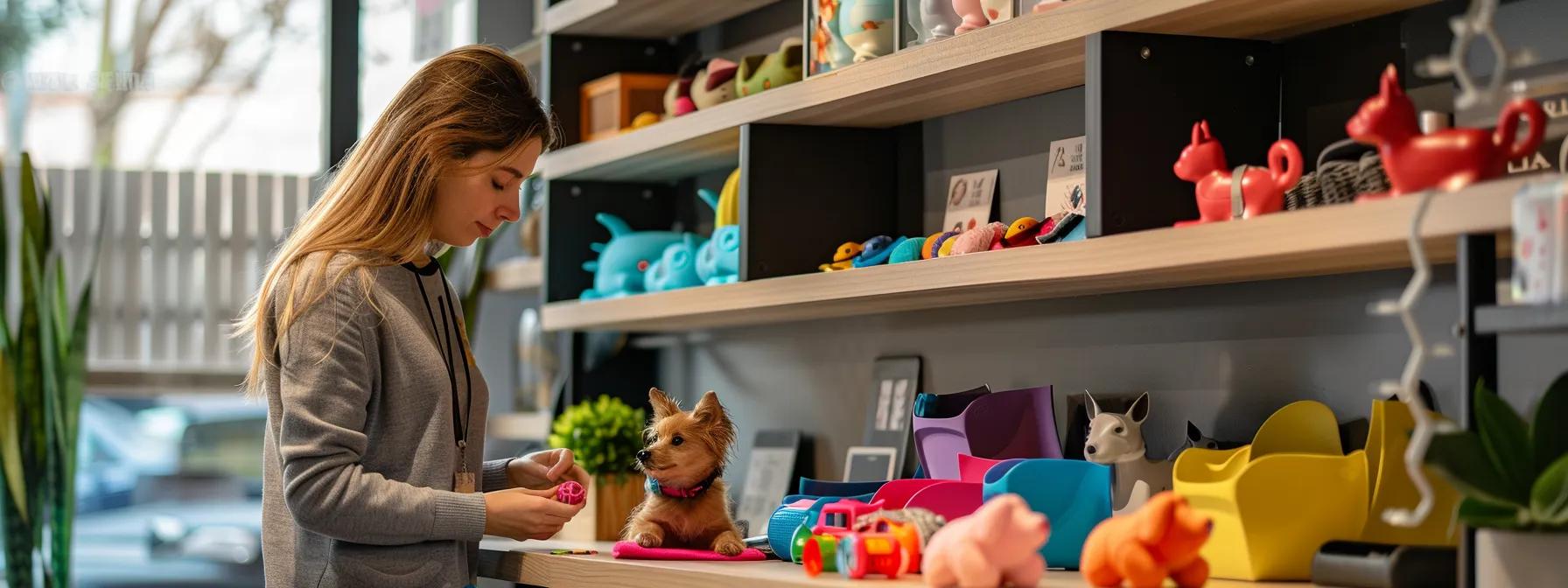
Maintaining and Inspecting Dog Toys for Ongoing Safety
Establishing a Regular Cleaning Method for Safe Dog Toys
Regular cleaning is essential for maintaining the safety of dog toys. Over time, toys accumulate dirt, bacteria, and other contaminants that can pose health hazards. Using pet-safe cleaning agents helps to ensure that toys are free from microbial buildup, which can lead to gastrointestinal infections or allergic reactions. A routine cleaning schedule, ideally aligned with the frequency of use, helps reduce these risks while extending the life of the toy by preventing material degradation caused by accumulated grime.
Manufacturers often provide guidelines for the proper cleaning methods of their products. For instance, rope toys should be cleaned with mild, non-toxic detergents and rinsed thoroughly to remove any residual chemicals. Similarly, cotton and natural fiber toys may benefit from machine washing on a gentle cycle, whereas rubber toys might need a quick wipe-down with disinfectant safe for pets. Consistent cleaning not only improves hygiene but also allows pet owners to notice early signs of wear or damage that may compromise a toy’s safety.
Routine cleaning also aids in preventing odor buildup and reduces the likelihood of attracting pests like mold or bacteria. Ensuring that the cleaning process itself does not introduce harsh chemicals is equally important—hence, the selection of pet-safe, fragrance-free cleaning solutions. Ultimately, establishing and adhering to a regular cleaning method is a cornerstone of maintaining ongoing toy safety, providing both dogs and pet owners peace of mind.
Recognizing Wear and Tear Indicating Unsafe Dog Toys
Wear and tear are natural outcomes of extended use by a dog; however, significant signs of deterioration indicate that a toy may no longer be safe for play. Frequent chewing, tugging, and rough handling can lead to frayed fibers, cracked surfaces, and weakened structural integrity. Pet owners should be vigilant in recognizing these early signs, as even a minor defect can evolve into a major safety hazard if left unattended.
Observing a toy’s surface for discoloration, loose threads, or structural breaks is crucial for determining if replacement is necessary. Toys that have begun to show signs of wear may shed small parts, which can cause choking or gastrointestinal blockages if swallowed. It is recommended that pet owners inspect their dog’s toys regularly and remove or repair any product that shows evidence of degradation. Keeping a maintenance log or periodic checklist can be an effective strategy for ensuring that no toy is overlooked.
Manufacturers provide estimated lifespans for toys, which can serve as a guideline, but individual play styles may accelerate wear and tear. The environmental conditions in which a toy is stored also affect its longevity; for example, exposure to moisture and sunlight can cause even high-quality materials to deteriorate faster. Recognizing these cues early and replacing risky toys prevents potential injuries and underscores the commitment to pet safety.
Knowing When to Discard Damaged or Unsafe Pet Toys
Determining the appropriate time to discard a pet toy is critical for ensuring ongoing safety. A toy that appears intact at first glance may have hidden internal damage or loose fibers that aren’t immediately visible. Pet owners should discard a toy as soon as any significant damage is noticed—such as torn seams, fraying material, or parts that detach easily. Regular monitoring of the toy’s condition enables early identification of risks that might not be evident during casual play.
Guidelines suggest that any toy failing to meet safety standards due to wear should be replaced immediately to avoid accidental ingestion of fragments. It is essential to maintain a proactive attitude toward replacing products rather than waiting for a potential incident to occur. Additionally, manufacturers sometimes recommend periodic replacement after a certain period of use, especially for toys that have been subject to heavy chewing.
Pet safety specialists advise keeping an inventory of all dog toys and noting the date of purchase or replacement. This practice can help draw attention to older toys that may require more frequent inspection. Ultimately, promptly discarding damaged or unsafe pet toys protects a dog’s health and prevents costly veterinary bills resulting from ingestion-related injuries.
Proper Storage of Dog Toys to Avoid Contamination
When not in use, dog toys should be stored in a clean, dry environment to prevent contamination and degradation. Proper storage methods help reduce the accumulation of dust, moisture, and pests, which can lead to mold growth or bacterial contamination. Containers with air-tight seals or dedicated toy baskets placed in cool, dry areas are ideal storage solutions.
Effective storage not only prolongs the life of the toys but also ensures that they remain fresh and hygienic for each play session. It is particularly important for toys made from natural fibers like cotton or hemp, as these materials can be susceptible to moisture-induced deterioration. A well-organized storage system allows pet owners to periodically review the condition of each toy without unnecessary handling, further minimizing wear and tear caused by repeated circulation.
Establishing a routine of storing toys appropriately after each use supports overall pet hygiene and keeps play areas clean and organized. Educating family members about proper storage practices also contributes to a safer environment for the dog. Ultimately, correct storage practices are an integral step in preventing accidental contamination, ensuring that every toy remains safe and enjoyable for extended use.
Performing DIY Toy Safety Inspections at Home
Regular DIY safety inspections of dog toys are a proactive measure that pet owners can implement to ensure ongoing safety. These inspections should include a careful visual and tactile assessment to detect any signs of damage or deterioration. Home safety inspections allow owners to examine every detail—checking knots, seams, and material consistency—to determine whether the toy remains safe for use.
Pet owners should adopt a set schedule for inspections, such as once a week, and use a checklist that includes common signs of wear like fraying fibers, cracked rubber, or loose components. These DIY inspections, when paired with regular cleaning and proper storage, create a comprehensive approach to maintaining pet toy safety. Additionally, some owners choose to document inspection findings in a log to identify recurring issues over time.
By performing these inspections, pet owners can preempt the risk of ingestion of hazardous fragments or injuries associated with weakened materials. This hands-on approach not only safeguards the pet’s health but also reinforces the importance of vigilance in the care of durable rope dog toys. Over time, routine checks may even inform purchasing decisions, encouraging buyers to choose higher-quality products that withstand rigorous use.
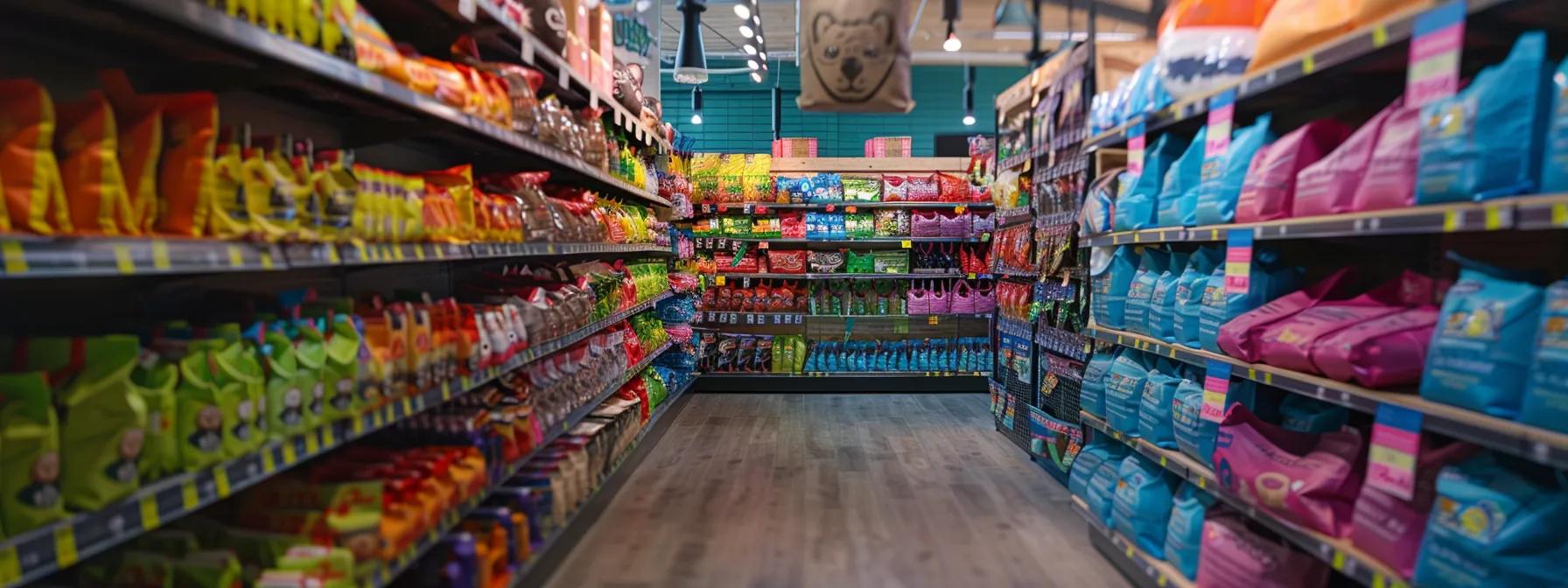
Deciphering Labels and Certifications for Non-Toxic Dog Toys
Reading Pet Toy Labels to Understand Material Composition
Labels on pet toys provide critical information about material composition and manufacturing standards. Reading these labels carefully ensures that pet owners can identify whether a toy is made from non-toxic, safe materials. Labels should clearly list ingredients and any substances used in the manufacturing process, such as natural rubber, food-grade plastics, or organic cotton. Detailed material composition helps consumers understand the potential risks and benefits linked to the toy, allowing them to make informed purchases.
Manufacturers committed to quality often include certifications or testing results on the packaging. Information such as “phthalate-free,” “BPA-free,” and “food-grade certified” indicates that the toy has undergone stringent testing and adheres to recognized safety standards. Reliable labels also state the manufacturing origin and quality control measures, such as third-party inspections and compliance with relevant international safety standards. This transparency is fundamental in verifying that the product meets the health requirements necessary for chewers.
Pet owners should be wary of ambiguous terms or labels that lack certification details. In such cases, additional research or contact with the manufacturer may be necessary to confirm that the toy is indeed free from harmful substances like heavy metals or toxic dyes. Reading pet toy labels thoroughly is one of the simplest yet most effective ways to prevent the accidental exposure of dogs to harmful chemicals present in poorly made toys.
Seeking Third-Party Safety Certifications for Dog Toys
Third-party safety certifications offer an independent validation of the material safety and construction quality of dog toys. Certifications from recognized bodies ensure that the product adheres to rigorous testing standards that evaluate everything from chemical composition to physical durability. These certifications can include marks such as the CE mark for products sold in Europe or certifications from organizations that specialize in pet product safety.
When searching for safe dog toys, pet owners should prioritize products that display these certifications. Third-party testing minimizes the risk that harmful chemicals—such as chlorinated compounds or improperly processed synthetic dyes—are present in the final product. Such certifications not only verify the absence of harmful substances but also assure that the toy can withstand the common stresses of dog play without degrading into dangerous fragments.
Manufacturers that invest in these certifications demonstrate a strong commitment to quality and consumer safety, which can translate into higher trust levels among pet owners. By leveraging reliable third-party verification, pet owners ensure that the toys they provide are both safe for regular use and built to last, protecting their pets from inadvertent exposure to toxic substances.
What "Non-Toxic" Signifies for Dog Products and Toys
The term “non-toxic” implies that a dog toy or product is free from substances that can cause harm when ingested, chewed, or handled. However, simply labeling a product as non-toxic does not automatically guarantee safety unless it is supported by rigorous testing and transparency in material sourcing. Non-toxic materials generally indicate that the product has been formulated with food-grade ingredients, natural fibers, or other certified safe components. This label assures pet owners that the product does not release harmful chemicals like formaldehyde, heavy metals, or dangerous plasticizers over time.
Understanding what “non-toxic” means requires pet owners to look beyond merely marketing claims. Reliable manufacturers will disclose the testing standards and certifications behind the claim, providing detailed information about the material constituents and their safety profiles. Non-toxic also extends to the absence of allergens that might provoke an immune response in sensitive dogs. For example, avoiding synthetic dyes and using natural colorants further reinforces the claim of non-toxicity.
By scrutinizing these claims, pet owners can evaluate the true safety of a dog toy. A true non-toxic label is an indicator that multiple layers of quality assurance have been applied, thereby reducing the risk of adverse health effects in pets, such as allergic reactions, poisoning, or gastrointestinal disturbances.
Questioning Ambiguous Marketing Language on Toy Packaging
Ambiguous marketing language on dog toy packaging can be misleading, particularly when terms like “eco-friendly,” “natural,” or “non-toxic” are used without clarification. Pet owners should approach such claims with caution and seek concrete information regarding the ingredients and safety certifications that support these assertions. Packaging that does not provide detailed material lists or fails to offer proof of independent testing should raise red flags regarding product safety.
It is essential for consumers to look for transparency in labeling, including specific chemical names and certification logos from third-party testing bodies. Ambiguity on packaging might obscure the presence of undesirable substances such as plasticizers or industrial dyes. In contrast, clear, detailed labeling allows pet owners to make informed decisions and avoid products that could potentially jeopardize their pet’s health.
Consumers can also utilize online reviews, manufacturer websites, and independent safety databases to confirm marketing claims. By questioning ambiguous language, pet owners become better equipped to choose products that have been genuinely vetted for safety and durability. This diligent approach not only protects their pets from potential hazards but also pushes manufacturers to adhere to higher standards of transparency and quality.
Locating Resources to Verify Dog Toy Safety Information
Verifying dog toy safety information involves consulting reputable sources such as regulatory agencies, independent testing organizations, and consumer review platforms. Resources like the U.S. Consumer Product Safety Commission (CPSC) or the European Chemicals Agency (ECHA) provide databases and guidelines that help evaluate the safety of pet toys and materials. Additionally, websites dedicated to pet product ratings compile data from independent studies and customer feedback, offering a comprehensive perspective on product performance and safety.
Pet owners should make use of these resources to cross-reference claims made on packaging. Looking up specific certifications, batch numbers, or manufacturer details on dedicated safety websites can offer additional assurance that the product is genuinely non-toxic. Social media groups and forums for pet owners are also valuable for sharing firsthand experiences, revealing potential issues with certain brands or products.
Ultimately, by leveraging multiple trusted sources, pet owners can achieve a well-rounded view of a product’s safety profile. This proactive approach in verifying dog toy safety helps minimize potential risks and ensures that pets receive the highest quality and safest products for their play time.
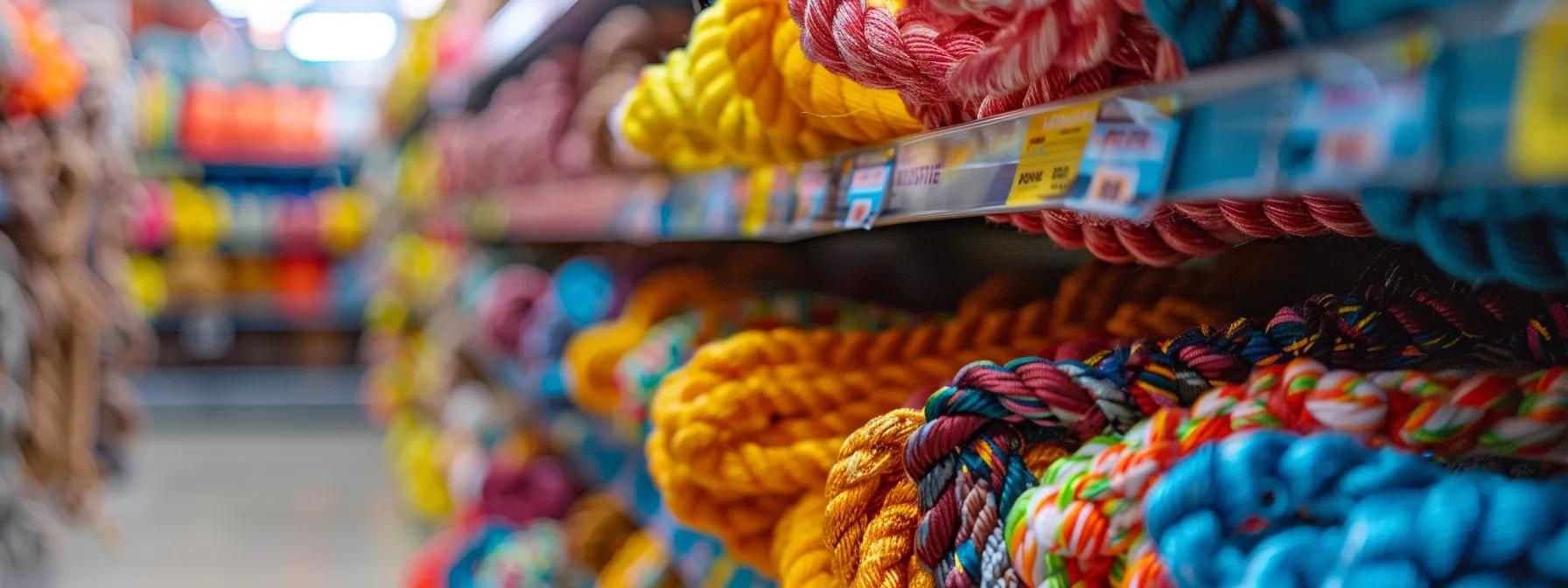
Final Thoughts
In conclusion, selecting safe materials for durable rope dog toys is integral to protecting a pet’s health and enhancing playtime safety. By understanding the differences between non-toxic components, natural fibers, and synthetic risks, pet owners can make informed purchases that avoid hazardous chemicals and choking risks. Constant inspection, proper storage, and adherence to third-party certifications further support ongoing safety and longevity of these products. Ultimately, investing in high-quality, well-constructed toys not only enriches a pet’s life but also offers peace of mind to their owners.
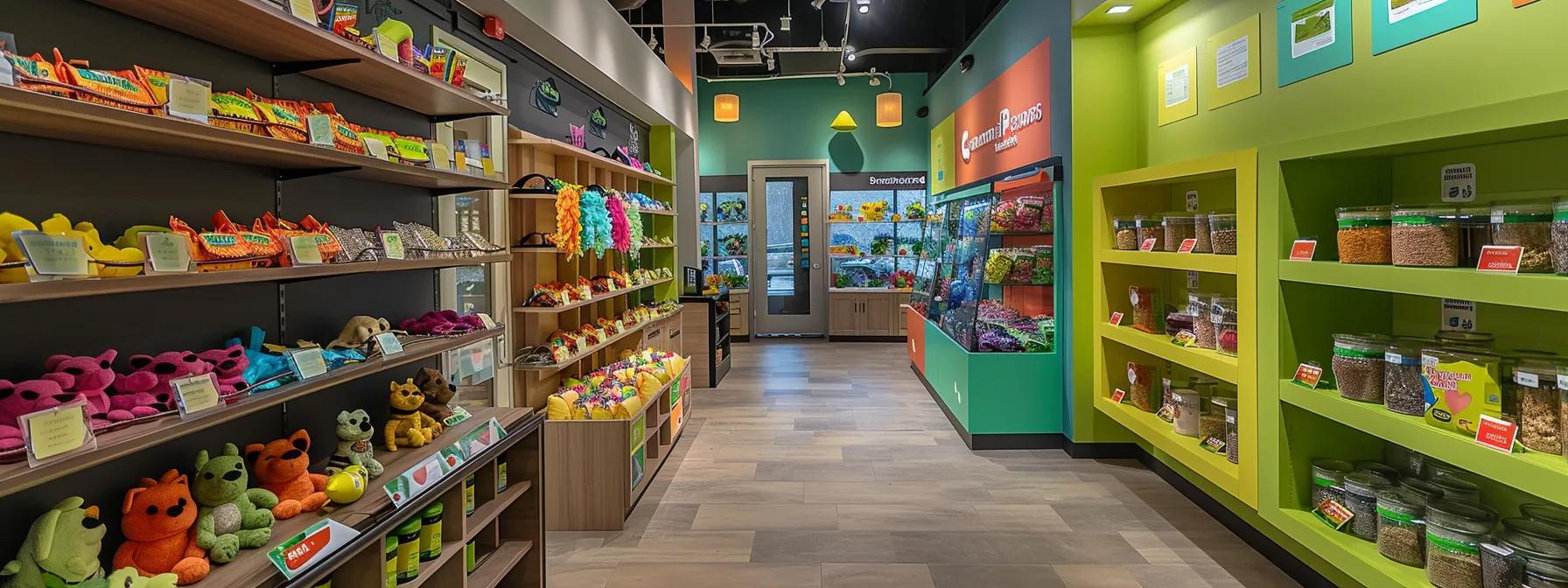
Frequently Asked Questions
Q: How can I ensure that my dog’s rope toy is safe? A: Look for products that list non-toxic, food-grade materials and have third-party certifications. Regularly inspect the toy for wear, ensure proper storage, and follow cleaning guidelines to maintain its safety.
Q: What should I do if I notice damage on my dog toy? A: Discard damaged toys immediately to avoid risks such as choking or ingestion of hazardous fragments. Replace them with high-quality alternatives and schedule regular safety inspections to monitor new toys.
Q: Are natural fibers always safer than synthetic ones for dog toys? A: Generally, natural fibers like cotton, hemp, and jute are less likely to contain harmful chemicals compared to some synthetic materials. However, verifying the quality and construction of the toy is essential since poor manufacturing can compromise even safe materials.
Q: What do labels like “BPA-free” and “phthalate-free” actually mean for my pet’s toy? A: These labels indicate that the toy has been manufactured without harmful chemicals like bisphenol A (BPA) and phthalates, which could leach and cause health issues. Always look for additional certifications to confirm overall safety.
Q: How often should I perform a DIY safety inspection of my dog’s toys? A: It is recommended to inspect your dog’s toys at least once a week. Regular inspections help detect signs of wear, allowing you to clean, repair, or replace toys to ensure they remain safe throughout use.



